Diamond Clarity
Don’t be a clarity case
Ringspo is reader supported
Ringspo is reader-supported, which means we may receive a commission if you click a link to a retailer & subsequently make a purchase.
We feature links to several retailers to help readers find the one that is the best fit for them. Find out more about how Ringspo works here.
Diamond clarity is the C that guys get overly excited about but girls tend not to worry about quite it so much. Guys often want to go for the best clarity they can, while girls don’t see what all of the fuss is about.
It’s also the characteristic that jewelers are often most keen to demonstrate when you are looking at diamonds in a jewelry store, which makes it easy to get caught up in wanting to get a ring with the highest clarity quality possible.
On this page we’ll look at what clarity is, how much it really matters and how you can avoid paying over the odds for it.
What is diamond clarity?
Clarity is basically a grading on the number of imperfections that a diamond has.
The size and number of the imperfections has a huge effect on the cost of a stone. This is important not only when buying your diamond, but also if you are ever looking to know how to sell your diamond ring and want to make sure you get the most money possible for it.
The imperfections came about during the natural formation of the stone, 3 million-ish years ago. As molten rock cooled to form the crystalline structure that makes a diamond a diamond, other minerals crept in and were included in the diamond as it formed.
Sometimes also called ‘flaws’, the imperfections are technically known as ‘inclusions’ if they are inside the stone or ‘blemishes’ if they are on the outside of the stone.
If they’re visible, the inclusions may look like the diamond on below – tiny black spots, or areas that are slightly more opaque.
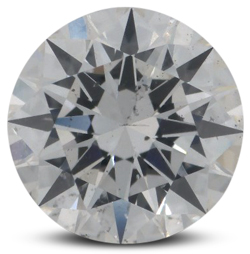
However, this is a stone that is far down the inclusion grading scale and has also been magnified by 20 times. Most inclusions are so small that they are impossible to see without a microscope. Stones that look like they are perfect when viewed with the naked eye are known as ‘eye-clean‘.
What are the different types of inclusion?
Different flaws were formed in different ways and some have a larger effect on the stone than others. Here’s four of the most popular, seen through a high-powered microscope. You are very unlikely to be able to see these on a diamond unless you go for one of the lowest grades of clarity.
You don’t need to know this information on the different types of inclusions, but it can be useful to understand some of the notes on grading reports. interesting to see.
Feathers
Feathers are whispy inclusions that sit inside a stone. If they’re small enough then they’re no big deal and are usually very difficult to see. However, if they reach the surface of the stone like the pic on the right then they can introduce a weak point in the diamond and make it much more likely that it will crack if it hits a hard surface.
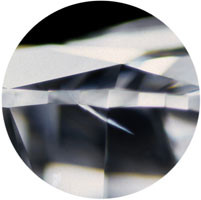
Cavities
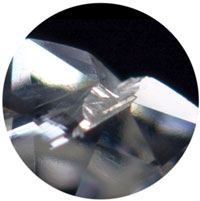
Chips can appear either when a feather is close to the surface of the stone and the edge of the feather is revealed during the polishing process.
Cavities can seriously impact the durability of a stone and should be avoided.
Needles
Needles are long thin needles of carbon within a stone’s structure that look like very small rods.
Although usually not visible, if they sit at the center of the stone underneath the top table they are much more likely to be visible.
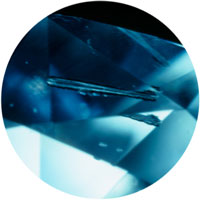
Clouds
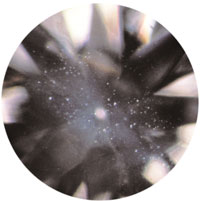
Images: GIA
Pinpoints are tiny white-coloured spots within a diamond that are actually another diamond crystal forming inside the diamond. They’re very difficult to see, even under a microscope, unless there is a large number of them grouped together.
Clouds are collections of pinpoints within a stone, and may be large enough to affect how much light travels through the stone. They’re marked on a grading report as a series of red dots close together.
How is clarity graded?
As with each of the 4Cs, diamond clarity is graded on a scale, with the grading recorded on every diamond’s certificate. This allows buyers to know exactly what they’re getting as they know that the stone has already been assessed and certified by an expert, which takes a lot of the guesswork out of the buying process.
The most common way of grading clarity is using the scale developed by The Gemological Institute of America (GIA). It rates stones from flawless all the way through to ‘imperfect’. One thing to note is how many of the clarity grades require a microscope to see the inclusions:
Flawless (FL)
No blemishes or no inclusions whatsoever – as perfect as a natural diamond can be.
Even under a microscope, a trained jeweler wouldn’t be able to see any flaws at all. Flawless diamonds are very rare, especially at a significant size – most jewelers don’t even have them on the books.

Microscope needed to see flaws
Internally Flawless (IF)
No internal inclusions can be seen inside the stone, but an expert may be able to detect some small surface blemishes visible under a 10x magnification microscope.
Normal people would not be able to see anything, even under a microscope.

Microscope needed to see flaws
VVS1 (Very, Very Slightly Included 1)
Tiny flaws are present, but they’re so difficult to see under a microscope that they’re basically non-existent.
An expert would be able to detect very small inclusions inside the stone when looking at it under 10x magnification from underneath ie. from the side that will be hidden by a ring setting.

Microscope needed to see flaws
VVS2 (Very, Very Slightly Included 2)

Microscope needed to see flaws
VS1 & VS2 (Very Slightly Included)
Small Inclusions that are easier to see under a microscope – even someone who didn’t know what they are looking for will be able to see them if them.
With a VS2, while some may be difficult to see, others will be quite obvious when viewed under 10x magnification.
Diamonds will still be ‘eye-clean’ though with no inclusions visible without using a microscope.

Microscope needed to see flaws
SI1 & SI2 (Slightly Included)
It’s easy to see the flaws using a microscope and you may, or may not, be able to see the flaws with the naked eye.
SI Clarity range can be a good compromise between affordability and quality, but it’s best to inspect the individual diamond you’re considering buying to ensure that it is eye clean.

May be able to see flaws with the naked eye
I1, I2 & I3 (Included)
Flaws can be seen with the naked eye – you don’t need a microscope to spot them. Roughly half the diamonds that are on the market today are in the I range, which means that 50% of the stones have noticeable flaws.
You should avoid diamonds with an I grade if you want your stone to look eye-clean and not have visible imperfections.

Flaws definitely visible with the naked eye
The tool below shows what each of the different clarity grades actually looks like:
Use the gold box slider to scroll through the differerent clarity grade, and then at each clarity grade you can use the arrows next to the diamond image to see see what an actual diamond looks like at that clarity grade and also see how they are represented on a GIA grading report.
Diamond clarity and price
Despite its limited effect on the actual appearance on a diamond, unless you go for a diamond at the bottom of the grading scale, clarity has a huge effect on price because of rarity.
Diamonds with no clarity characteristics are rare. Diamonds take about 300 million years to grow, give or take a few, and in this time it’s very likely that they would have encountered other minerals that would have been introduced and created imperfections. Also, the larger a diamond is, the longer it would have taken to grow, so the more likely it was that imperfections and flaws would be formed.
To show how size can affect price, I conducted an experiment using on of my recommended retailers.
I looked at round brilliant diamonds with identical specs in all of the other Cs, and just changed the clarity grade. The specs I kept consistent were:
- Carat: 1
- Color: G
- Cut: Excellent
The difference in price can be seen below:
| Clarity | Price (USD) | Difference (USD) | Difference (%) |
|---|---|---|---|
| F | $9,988 | $0 | 0% |
| IF | $8,408 | -$1,580 | -15.8% |
| VVS1 | $6,628 | -$3,360 | -33.6% |
| VVS2 | $6,359 | -$3,629 | -36.3% |
| VS1 | $5,960 | -4,028 | -40.3% |
| VS2 | $5,434 | -$4,554 | -45.6% |
| SI1 | $4,698 | -$5,290 | -53.0% |
| SI2 | $4,104 | $5,884 | -58.9% |
| I1 | $3,879 | -$6,109 | -61.2% |
Looking at the table you can see that there are some big differences.
When you’re looking for your diamond the actual percentage differences may be a little difference depending on the size of the stone you’re looking for etc, but these numbers are a good basis for showing how clarity affects price.
Flawless stones are obviously the most expensive, but then the price drops away very sharply even for grades like IF, VVS1 and VVS2 where you would need to be a jeweler to be able to see the flaw through a microscope and a normal person wouldn’t be able to see them, even at 10x magnification.
VS2, where diamonds are ‘eye-clean’ and impossible to see without a microscope are a huge 45.2% less expensive than flawless stones at this size, color and cut.
SI1 and SI2 stones (which may be eye-clean but you need to inspect the individual stone) are over 50% less expensive. If you find an eye-clean stone at SI1, you’ll be able to pay for a good chunk of your honeymoon with the difference in price, while the stone will look exactly the same as a Flawless stone unless it’s examined under a microscope (which not too many people carry around in their pocket to inspect diamonds with..)
Check out the two stones below – one is an IF and one is an SI1 stone, both magnified at 20x. However, even at this super zoomed-in magnification the SI1 looks eye-clean, so will definitely appear completely perfect once mounted in a ring. Is it worth paying the extra premium for the Internally Flawless stone? That’s up to you, but I’d say no..
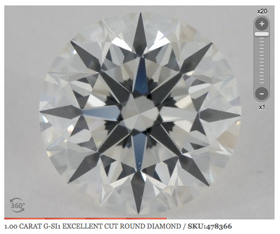
Diamond size and clarity
The larger a stone is, the more likely it is that it has inclusions.
It’s a result of diamonds being naturally occurring. Larger rough diamonds took longer to grow than smaller ones, so are more likely to have run into the conditions that produce flaws. They’re more likely to have encountered other minerals that would creep in and show up as inclusions, or be subject of cooling and then reheating which can affect the way the diamond crystal forms.
What this means is that the size of a diamond can have a big effect on the visibility of inclusions, as well as its clarity grading.
For smaller stones ie. less than 0.50 carats, stones graded with VS2 will be eyeclean. Most SI1s and SI2s should be eyeclean too, but if possible you should examine them to make sure. If you’re buying online, then ask for close-up pics.
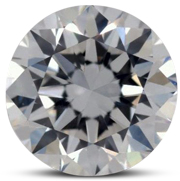
It’s a similar story with medium-sized stones. Between 0.50 and 1.00 carats, VS2 and above will be eyeclean. Most SI1s should be eyeclean too, but again if it’s possible to examine them you should.
With larger stones – between 1.00 and 1.50 carats – VS2 diamonds and above should be eye-clean, but a VS2 may benefit from being inspected. SI1s and below at this size will not be eye-clean.
With stones bigger than this, especially above 2 carats, SI1s and below will definitely not be eye-clean and you should really be looking at VS1 or higher.
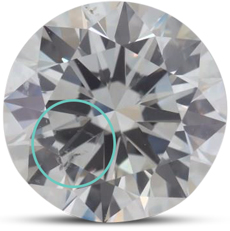
So, as the carat size increases, the visibility of flaws increases but so too does the tolerance of the flaws. The larger you go, the higher clarity you should go for.
Buying diamonds online and clarity
Buying diamonds online is definitely the best way to get access to the widest choice and the best prices. No bricks and mortar retailer can match the selection and competitiveness of the diamonds found through my recommended retailers.
However, there are certain instances where certain online retailers are better than others, and that’s mainly when looking at diamonds which are on the lower clarity grades.
Choosing borderline clarity diamonds
As discussed in the previous section, different sizes of diamonds, and indeed different shapes, will show different levels of flaws and imperfections at the same quality grade. However, even diamonds that score exactly the same on every category of the 4Cs can appear very different.
The below two stones are both:
- Carat:
- Colour: G
- Cut: Excellent
- Clarity: SI1
If the inclusion is in the ‘table’ of the stone (the flat bit at the top), it’s likely to be more visible than if it was close to the edge. This is particularly important if you’re looking at diamond shapes with a large table e.g. an emerald cut.
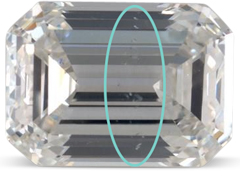
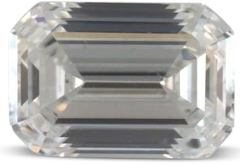
Despite the two stones being graded at the same level of clarity, the whopping great run of flaws down the middle of the left stone are much more obvious than any inclusions on the stone on the right, mainly because of where they’re located.
The answer
If you are planning on choosing a diamond which is on the border of either being eye-clean or with inclusions that are easily visible, then you need to make sure that you can inspect the individual stone that you are considering.
The way to do this is to use an online retailer that offers high-quality and zoomed in images of each individual stone, so you can inspect the merchandise and then make your own decision.
James Allen in particular offers extremely high quality imagery of every single diamond they sell.
If you are planning on choosing a stone that is on the borderline clarity-wise (ie. Slightly Included 1 or below, or VS2 for larger stones) then these two retailers are the only two retailers that I would recommend choosing your stone from.
How important is clarity, really?
Clarity is often confused as the defining factor in a stone’s ‘quality’.
When people first learn a little bit about the 4Cs, it’s not uncommon for them to assume that if a stone has no or very few imperfections, it must be high quality, while one with imperfections must be low.
This is a very simplistic view, and clarity is just one of the 4 Cs that need to be considered.
When looking at diamonds, most people are concerned with how well it sparkles. It’s the most obvious attribute of a diamond and a good quality stone can catch your eye from across the room.
So, if sparkle is your yardstick for quality then clarity doesn’t have too much affect on the stone’s performance unless there is a large grouping of flaws that affects how much light can actually pass through.
Cut is a much more important factor in how well a diamond performs ‘optically’ ie. how much light passes through it and is reflected to your eyes, making it sparkle.
Does clarity matter then?
How much diamond clarity matters is up to you and the relative balance of the 4Cs that you can squeeze into your budget.
When I first started looking at diamonds and learnt a little about clarity and imperfections, I was keen to go for the highest clarity I could. I wanted my stone to be really top quality.
This is a trait I know a lot of guys share with me – we want to know that we have the best of everything.
Like a lot of guys I know, I obsess over details when I’m doing research before buying something. I want to know that my mountain bike has the most suspension travel in its class, my phone screen has the most pixels and my food mixer has enough power to blend an iPad (it can and there’s a video on YouTube to prove it). We like to go for the ‘best of breed’ of everything.
Really though, these requirements are excessive. Although I have six inches of suspension travel on my bike, I’m lame enough at mountain biking that four would do. It doesn’t help me stay on my bike any more than my friends. My phone has a 4k screen which means that I can watch HD movies on the toilet, but it’s way beyond what I need for Facebook and grainy YouTube videos of squirrels on waterskis. And though it’s useful to know that I can destroy all the household electronics I please, all I really use the blender for is making short work of the odd kumquat.
With each of these, I could have saved cash by settling for the ‘best of need’, rather than ‘best of breed’.
Which clarity grade?
When you’re buying a diamond engagement ring, you need to find the balance of the 4Cs that is right for you and your budget.
Clarity is just one of the factors that you need to consider, but you should think about whether a rock with a higher clarity rating is worth paying significantly more for than a stone with a lower rating that will look the same to the naked eye.
For me, the sweet spot is VS2 diamonds – they strike the right balance between being eye-clean and being affordable.
If you’re on a budget then SI1 and SI2 stones can be eye-clean, but you need to make sure that you can see a zoomed-in image of them to make sure that no flaws are visible.
Ultimately you want to get the most impressive ring you can, and if quality to people who are looking at the ring is defined as how much it sparkles, then cut is a much bigger contributor to this than clarity and you should focus your budget there.
Learn about the rest of the 4Cs

Carat
Find out why biggest isn’t always best

Cut
The most important ‘C’
of all

Color
Make sure it makes a difference

